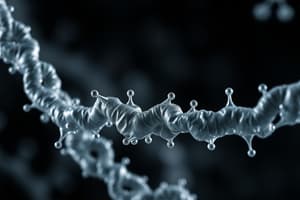Podcast
Questions and Answers
What are the four major classes of biomolecules?
What are the four major classes of biomolecules?
Carbohydrates, proteins, lipids, and nucleic acids
What is the primary source of energy for living organisms?
What is the primary source of energy for living organisms?
Carbohydrates
What are the building blocks of proteins?
What are the building blocks of proteins?
Amino acids
Which biomolecule forms complex structures like secondary, tertiary, and quaternary conformations?
Which biomolecule forms complex structures like secondary, tertiary, and quaternary conformations?
What is the role of nucleic acids in regulating gene activity?
What is the role of nucleic acids in regulating gene activity?
What is the main function of lipids in the human body?
What is the main function of lipids in the human body?
Explain the role of nucleic acids in protein synthesis.
Explain the role of nucleic acids in protein synthesis.
How do the sequence of amino acids in proteins influence their structure and function?
How do the sequence of amino acids in proteins influence their structure and function?
What is the genetic information carried by DNA responsible for?
What is the genetic information carried by DNA responsible for?
How do carbohydrates, proteins, lipids, and nucleic acids collectively contribute to the functioning of living organisms?
How do carbohydrates, proteins, lipids, and nucleic acids collectively contribute to the functioning of living organisms?
Flashcards are hidden until you start studying
Study Notes
Biomolecules: Understanding the Diverse World of Carbohydrates, Proteins, Lipids, and Nucleic Acids
Biomolecules are the fundamental building blocks of life that perform various essential functions within cells and organisms. They are organic compounds with biological roles in growth, development, and maintenance of living systems. There are four major classes of biomolecules: carbohydrates, proteins, lipids, and nucleic acids. Each class plays unique roles in sustaining life processes.
Carbohydrates
Carbohydrates are polyhydroxy aldehydes or ketones, often referred to as sugars due to their sweet taste. They are classified into monosaccharides (simple sugars like glucose), disaccharides (double sugars like sucrose), oligosaccharides (short chains of sugars), and polysaccharides (long chains of sugars like starch and cellulose). Carbohydrates serve as the primary source of energy for living organisms and are crucial structural components, particularly in plant cell walls through the formation of cellulose fibres.
Proteins
Proteins are polymers made up of amino acids arranged in long chains called peptides, forming complex structures like secondary, tertiary, and quaternary conformations. They play various roles such as providing structure to cells (e.g., myosin in muscle movement), acting as enzymes that catalyze biochemical reactions, and regulating gene activity through transcription factors. The sequence of amino acids determines the protein's unique three-dimensional structure and function.
Lipids
Lipids are hydrophobic molecules composed primarily of fatty acids esterified with glycerol (forming triglycerides), cholesterol, or other alcohols. These molecules serve multiple purposes, including providing energy storage (e.g., triacylglycerols in adipocytes), acting as structural components of membranes and cell signalling agents (e.g., phospholipids). Lipids play crucial roles in insulation, protection, and maintaining fluidity in cellular environments.
Nucleic Acids
Nucleic acids, specifically deoxyribonucleic acid (DNA) and ribonucleic acid (RNA), carry genetic information through the sequence of nucleotide bases. DNA contains the hereditary code that determines an organism's traits, while RNA participates in protein synthesis by carrying amino acids together in specific sequences directed by messenger RNA (mRNA). The structure of these molecules allows them to store, replicate, and manipulate genetic information essential for life.
In conclusion, understanding the functions and complexities of biomolecules provides insight into how they contribute to the intricate workings of living beings. Their diverse structures and interactions enable a wide range of physiological processes necessary for growth, reproduction, and survival.
Studying That Suits You
Use AI to generate personalized quizzes and flashcards to suit your learning preferences.




